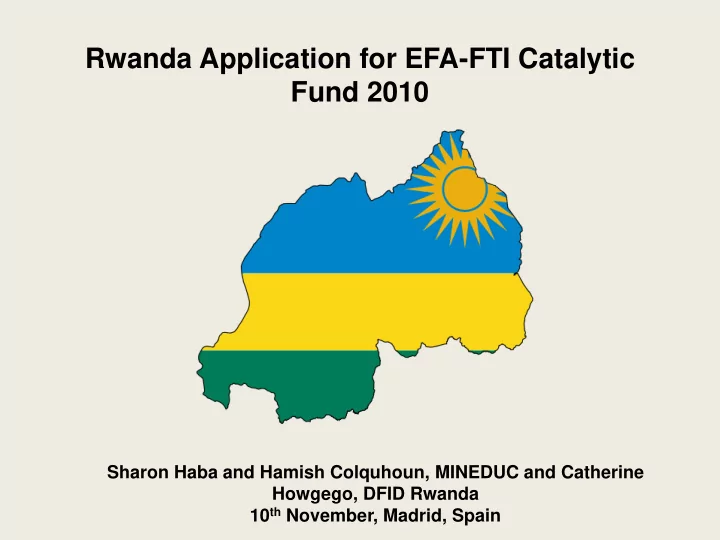

Rwanda Application for EFA-FTI Catalytic Fund 2010 Sharon Haba and Hamish Colquhoun, MINEDUC and Catherine Howgego, DFID Rwanda 10 th November, Madrid, Spain
Before FTI: Rwanda in 2006 • Sharon – to get some photos from Emile and put some captions to them. We’ll then choose 4 (2 for each slide) and talk to them
FTI IMPACT: Rwanda in 2010 • As before
FTI IMPACT: STATISTICS (Primary) Indicator 2007 2008 2009 2010 GER Boys 151% 127% 127% 125% GER Girls 153% 129% 129% 128% NER Boys 96% 94% 93% 94% NER Girls 97% 95% 94% 97% Completion Boys 51% 52% 71% 71% Completion Girls 53% 53% 78% 80% Pupil : Qualified Teacher 75 73 63 63 Ratio Transition Boys 57% 90% 96% Available 2011 Transition Girls 53% 86% 94% Available 2011
ESSP 2010-2015: FOCUS AREAS • Completion and transition rates improved • Quality continues to improve • Skilled and motivated teachers • Relevant post basic education • Equity at all levels • Strengthening of education in science and technology • Functional institutional framework for effective management capacity
ESSP 2010-2015 FRAMEWORK Ministry of Development Private Education Partners Sector EMIS/M&E/NIF FBOs DEOs Schools Community NGOs PTAs ESSP
Equity and Inclusion • Scoping study ongoing – small sample • Preliminary reasons for exclusion: – Lack of facilities, trained teachers – Limited capacity for assessing learning difficulties • Strengths & directions: – Growing pro-education culture, pro- child policy environment – Child Friendly Schools, child centred teaching, PTAs – Capitation grants – Improved focus on learning outcomes
ESSP 2010-2015: IDENTIFIED CHALLENGES • Does the switch to English Language impact on learning outcomes? • Will the lack of ECD teachers and public provision impact on completion rates and learning outcomes? • Does the Ministry have the capacity to implement this ambitious plan? • Will the financing gap be met?
Evolution of Budget 2006-15 Expenditure Resources External Support FTI 700 600 USD Million 500 400 300 200 100 0 2006 2007 2008 2009/10 2010/11 2011/12 2012/13 2013/14 2014/15
How financing gap might be filled 3 year (2010-13) financing gap $330.6 million GoR allocation increase to 21% $122.9 million Continued community support $103.2 million Increased external support $104.5 million
Community support • Parents, communities, NGOs, FBOs, army contributing money, materials and labour • Fundamental in achieving massive 9YBE school construction 2009/10 3,072 classrooms 9,145 latrines • Fatigue?
Contingency Planning – Scenario impacts on targets Baseline 2015 2009 Scenario 1 2 3 Cumulative funding gap $237m $433m $819m Funding gap as % of total 11% 19% 31% expenditure Primary: Repetition 15% 12% 12% 10% Pupil-teacher ratio 63 53 47 47 % teachers double shifting 100% 95% 85% 80% Average teacher salary as 2.0 3.3 3.6 3.9 multiple of GDP per capita
Fiduciary Risks • Education FRA January 2010 – moderate risk • Very low levels of corruption – evidence of action being taken against corrupt officials. Lowest in region. • Auditor’s general report now addressed at joint review meetings • Plans for additional training on use of capitation grants at the school level • PFM capacities enhanced through training in accountancy and financial management, development of an integrated financial management information system, and increased staffing at decentralised levels
MURAKOZE GRACIAS
Recommend
More recommend